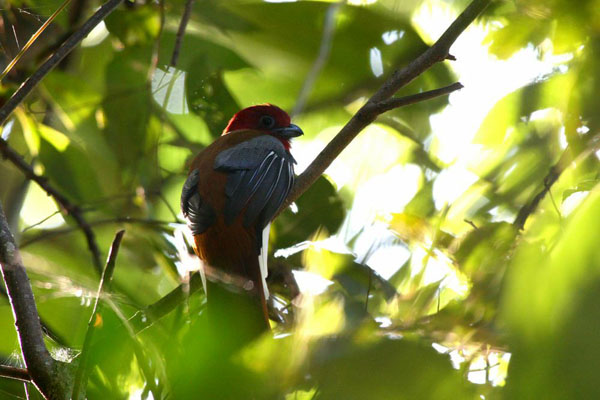Harpactes erythrocephalus
IUCN
LCBasic Information
Scientific classification
- name:Harpactes erythrocephalus
- Scientific Name:Red Pigeon,Harpactes erythrocephalus,Red-headed Trogon
- Outline:Climbing birds
- Family:Trogonidae
Vital signs
- length:About 33 cm
- Weight:75-110g
- lifetime:
Feature
The male bird is distinguished by its red head, and the female bird is distinguished from other female trogons by its red abdomen.
Distribution and Habitat
In China, it is found from southern Sichuan to Guizhou, Yunnan, Fujian, Guangdong, Hainan Island and southeastern Tibet. Abroad, it is found from the Himalayas to Southeast Asia and Sumatra.
It lives in tropical rainforests, especially secondary dense forests, mainly in evergreen broad-leaved forests and secondary forests below 1,500 meters above sea level. It can reach 2,300 meters in the middle mountain areas of Gaoligong Mountain in Yunnan, China.
Appearance
The body is mostly red, large, with a round head and a long tail. The male has a red head, a red chest with a narrow half-moon-shaped white ring, and the collar on the back is missing; the female has a yellow-brown head, which is different from all other trogons. The red color of the chest and abdomen is not as bright as that of the male, and there is a half-moon-shaped white ring on the lower chest. The iris is brown, the skin around the eyes is blue, the beak is almost blue, and the feet are pink.
Details
Red-headed Trogons are mostly single or in pairs; they live in trees, either climbing on the top branches of small trees to eat wild fruits, or standing quietly on tree branches waiting for an opportunity to attack flying insects, and occasionally following flying insects. They have poor flying ability, and although they are fast, they do not fly far. Their calls are a bit like the fragmented meows of cats, usually three intermittent "shiu" sounds, which are issued leisurely, about 5 or 6 times a minute. When attacking insects or when frightened, they often make a single noise like "krak", but they are usually very quiet. Not only do they not like to call when they are perched, but they are also very quiet when they come and go. They are timid and solitary, often standing vertically on the low branches of the canopy or on vines. When flying, they often fly in the forest in an ups and downs wave-like manner.

Mainly feeds on insects and insect larvae. Also eats plant fruits. Often preys in the air by flying. But can also prey on the ground.

The breeding season of the red-headed trogon is from April to July. They choose natural holes in rotten tree stumps or abandoned nests of woodpeckers in the depths of dense forests as their nests. They usually nest in natural tree holes, and sometimes they dig holes on dead trees to nest. There is no bedding in the hole, and the eggs are laid directly in the hole. Each nest has 3-4 eggs, which are blunt oval or oval. The color is light yellow or coffee, very smooth. The size of the egg is 26-33×22-26 mm; the average is 29×24 mm. Male and female participate in incubation and brooding. The chicks are late-maturing.
Listed in the second level of the "List of National Key Protected Wildlife in China".








